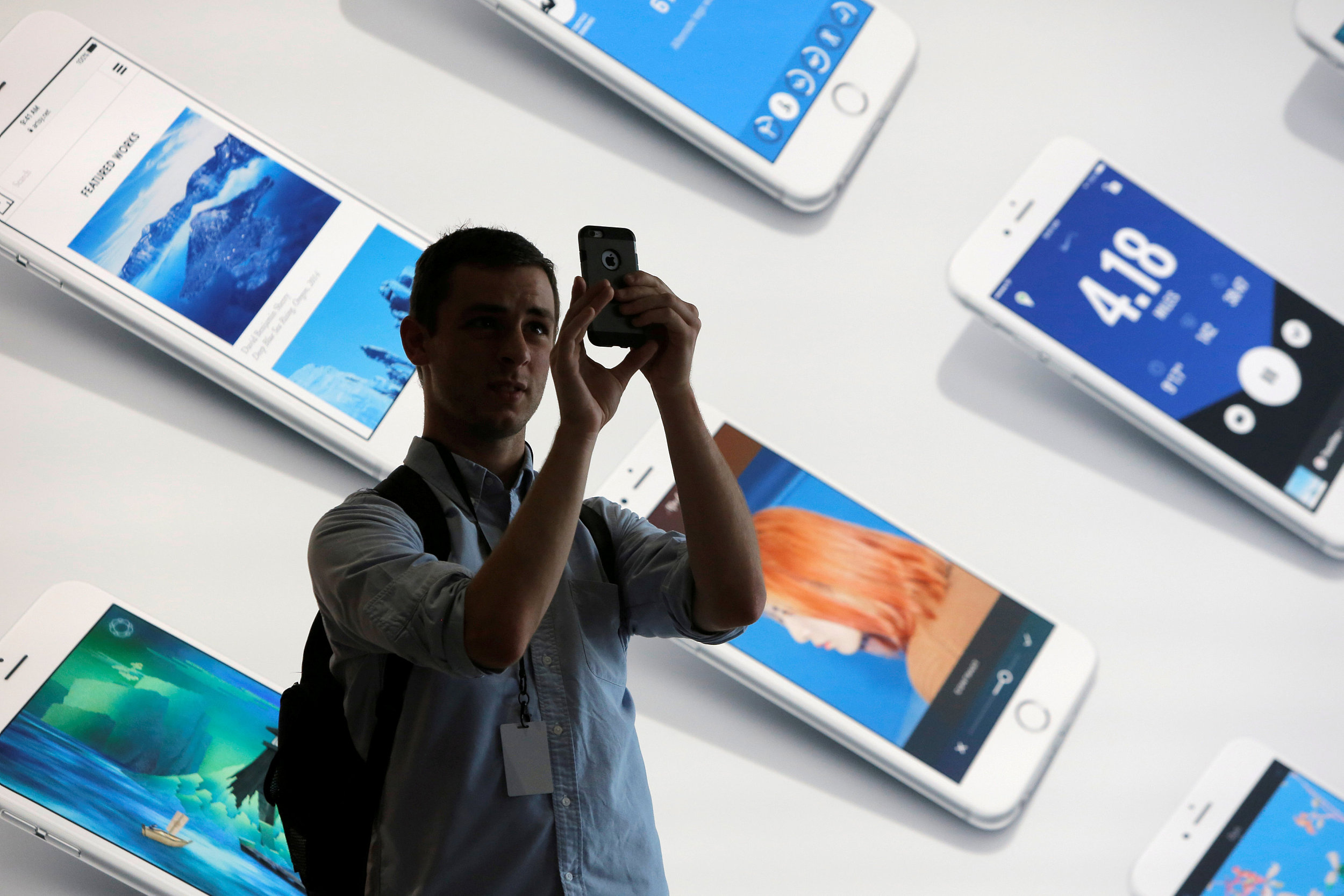iPhone:從6個方面改變了世界

|
不知不覺間,iPhone已經(jīng)走過了十個年頭。十年一個里程碑,有人或許會覺得有些不真實感,仿佛這款手機是自來就有的。其實,喬布斯站在舊金山的發(fā)布會舞臺上將iPhone第一次介紹給消費者的那一幕,很多人至今依然歷歷在目。十年彈指一揮間,不知不覺間,iPhone已經(jīng)讓這個世界變了一副模樣。要想完完全全總結(jié)它對全世界的影響,其實是很難的。 當(dāng)我們說到iPhone以及它對世界的影響時,有幾件事情是我們經(jīng)常提起的,比如它的應(yīng)用程序,它如何加速了人與人的聯(lián)系(當(dāng)然,它也總是那么勾魂,總是讓人分心,叫我們沒法好好工作),以及它那簡約的工業(yè)設(shè)計。除了這些因素之外,iPhone其實還給世界帶來了一些同樣具有革命性的變化。 多點觸控的大范圍應(yīng)用 我們之所以只用幾根手指就能完成與智能機的交互,這主要歸功于多點觸控技術(shù)。現(xiàn)在,使用智能手機的人已經(jīng)比使用傳統(tǒng)PC的人多了好幾億。我們有大量信息的傳送都是通過觸屏完成的。而iPhone正是第一款大規(guī)模市場化的消費級多點觸控產(chǎn)品,并且取得了巨大的成功。 今天,你已經(jīng)很難找到一臺沒有多點觸控屏的手機或平板電腦了。每次我們看到一款無鍵盤的智能設(shè)備,就會自然而然地認(rèn)為,我們可以用手指在上面滑動、縮放和拖動。而這完全要感謝iPhone。 可玩性強的用戶界面 曾在蘋果公司擔(dān)任用戶界面設(shè)計師和早期iPhone構(gòu)建師的巴斯·奧爾丁曾經(jīng)對我說:“我一直搞不清楚,以前的軟件為什么做得那么無聊。”直到世紀(jì)之交時,一般軟件的用戶界面依然做得十分乏味。iPhone人性化界面部門負(fù)責(zé)人格雷格·克里斯蒂稱,當(dāng)時的軟件界面“不是按鈕就是按鍵”。而iPhone的軟件設(shè)計團隊卻徹底改變了這一歷史。奧爾丁受早期視頻游戲的啟發(fā),給iPhone的操作系統(tǒng)設(shè)計了很多令人愉快的觸摸效果——比如當(dāng)你把網(wǎng)頁翻到最底部時的“橡皮筋”反饋效果;再比如輕輕抖動的圖標(biāo),和看起來相當(dāng)酷炫的應(yīng)用等。 最高效的供應(yīng)鏈 一個蘋果養(yǎng)活了好幾家中國的大工廠。但是早在蘋果之前,就有不少歐美企業(yè)將生產(chǎn)外包到了中國。在iPhone之前,“美國原產(chǎn)”曾一度是蘋果用來自我標(biāo)榜的一個賣點,而且它的“美國原產(chǎn)”的歷史比大多數(shù)競爭對手都長得多。但是到了iPhone時代,蘋果已經(jīng)把代工玩到了極致。蒂姆·庫克當(dāng)上運營總監(jiān)后,他把各個盤根錯節(jié)的零部件工廠壓成了一根繃得緊緊的彈簧,幾十萬裝配工人都在圍繞這個設(shè)備服務(wù),這條供應(yīng)鏈具有很大的張力,完全可以滿足蘋果對產(chǎn)能的需求。通過供應(yīng)商之間的緊密協(xié)作,以及盡可能從勞動力中壓榨出更高的效率,庫克將現(xiàn)代化的設(shè)備生產(chǎn)引向了一個新臺階——當(dāng)然同時也引來了不少人權(quán)方面的抨擊。 傳感器浪潮 從它誕生的第一天開始,iPhone就用上了包括加速計和近距離傳感器在內(nèi)的各種傳感器,使它簡直成了一款有魔法的產(chǎn)品——比如打電話的時候屏幕會變黑,這樣你就不用擔(dān)心你的耳朵會誤觸屏幕,另外隨著你握持姿式的變化,它還會自動變成豎屏或橫屏模式。iPhone可以說是軟件與硬件的完美結(jié)合,它設(shè)立了智能設(shè)備的標(biāo)桿,掀起了一股大規(guī)模運用傳感器的浪潮。今天,除了早期iPhone上的那些傳感器外,陀螺儀、指紋掃描器等傳感器也早已成為智能手機的標(biāo)配。如果沒有這些傳感器,有些最有影響力的iPhone游戲甚至根本都玩不了。 智能個人助手 人們一開始只把Siri當(dāng)成一個新奇的玩意,而不是一個強大的用戶界面。Siri剛剛發(fā)布時,遭到了人們的廣泛嘲笑。但Siri確實是第一個走向主流的人工智能用戶助手,它為基于語音識別技術(shù)的用戶界面開辟了道路。雖然有人指出,亞馬遜的Alexa和谷歌助手已經(jīng)在功能性和實用性上超過了Siri,但毫無疑問,Siri才是第一代正宗的智能語音助手。 開啟全新經(jīng)濟業(yè)態(tài) 我們可能還沒有完全意識到,蘋果所催生的“應(yīng)用經(jīng)濟”的規(guī)模究竟有多大。一位知名行業(yè)分析師曾指出,蘋果開啟的“應(yīng)用經(jīng)濟”要超過整個好萊塢的規(guī)模。 在蘋果的營收中,應(yīng)用貢獻的收入只是九牛一毛——iPhone的銷售收入才是蘋果營收的大頭。然而誕生僅僅十年后,iPhone的價值已經(jīng)遠遠不是幾個好萊塢能夠比擬的。(財富中文網(wǎng)) 本文作者Brian Merchant是《The One Device: The Secret History of the iPhone》一書的作者,也是科技網(wǎng)站Motherboard的編輯。 譯者:樸成奎 |
The iPhone turns 10 years old this year, and it's a landmark that can feel a little surreal. Somehow, it seems like the device has existed forever, yet that image of Steve Jobs standing on a San Francisco stage and bequeathing the iPhone unto the masses feels as vivid as ever. The iPhone has changed so much, so seamlessly, in such a short amount of time, it's hard to grapple with the full scale of its impact. There are a few things that most commonly get cited when we talk about the iPhone and its imprint on the world—its apps, how it accelerated mass connectivity (and its nefarious alter-ego, constant distraction), or its sleek industrial design. But there are a host of others shifts the iPhone ushered in that are equally, if not more, revolutionary. Multi-touch for the masses It’s a little remarkable that we don’t spend more time talking about multi-touch, the technology that allows us to fluently speak to computers with our fingers. Many hundreds of millions more people use smartphones than traditional PCs; we transmit information by touch, on screens. The iPhone was the first mass-market consumer product to feature a multi-touch-capable screen that really sung. Today, you’d be hard-pressed to find a phone or a tablet that doesn’t have a multi-touch-powered screen. When we approach a smart screen without a keyboard attached, we naturally assume we’ll be able to swipe, pinch, zoom, and drag pixels around at our whim—that’s entirely thanks to the iPhone. Playful user interface “I never got why software had to be boring,” former Apple user interface designer and early iPhone architect Bas Ording told me. As recently as the turn of the century, user interface design was as deadly dull as it sounds. It was “all knobs and dials,” Greg Christie, head of Apple’s Human Interface Group, told me. The software design team that engendered the iPhone would change that forever. Ording, inspired by early video games, baked pleasant little touches—the “rubber banding” effect when you scroll to the end of a list, jiggling icons, and stylish-looking apps—into the iPhone operating system. Maximum-efficiency supply chains Companies were outsourcing manufacturing long before Apple sped the rise of device megafactories in China—in fact, Apple proudly manufactured its products in the U.S. much longer than most of its competitors did—but the iPhone drove the practice to perfection. When he was head of operations, Tim Cook coiled Apple’s tangled cluster of component factories into loaded spring, manned by hundreds of thousands of laborers, that could be unleashed to meet demand. By grouping suppliers together in close proximity so that they could rapidly collaborate to address changes in hardware or design, and demanding new untold levels of efficiency from the workforce, he set the stage for the modern model of device manufacturing—and the human rights woes that accompany it. The sensor boom From day one, the iPhone made use of a wide array of sensors, from an accelerometer to a proximity sensor, to make it feel more like magic—the screen would go dark so you wouldn’t touch buttons with your ear, or it’d seamlessly switch into landscape mode. An elegant marriage of software and hardware, the iPhone both set the standard for a smart device, and set off the sensor boom. Today, these early tools share space with a gyroscope, fingerprint scanner, and other enhancements—many of the iPhone’s most influential games and apps would be powerless without them. The intelligent personal assistant Siri may have been more of a novelty than a powerful interface at first, and it was widely derided upon launch. But as the first mainstream, user-facing artificially intelligent assistant, it blazed a clear trail for a voice-operated user interface. Even though critics argue that Amazon’s Alexa or Google Assistant have surpassed Siri in terms of power and usefulness, there’s little doubt who ushered in the boom. A brand new economy We still may not quite have internalized the sheer scale of the app economy that Apple spawned. It is, as a top Apple and technology industry analyst has argued, bigger than Hollywood. Apps make up just a small, almost invisible sliver of Apple’s revenue—which is still dominated by iPhone sales. Just a decade after its creation, the iPhone is bigger than too many Hollywoods to count. Brian Merchant is author of The One Device: The Secret History of the iPhone and an editor at Motherboard, Vice's science and technology site. |
-
熱讀文章
-
熱門視頻











